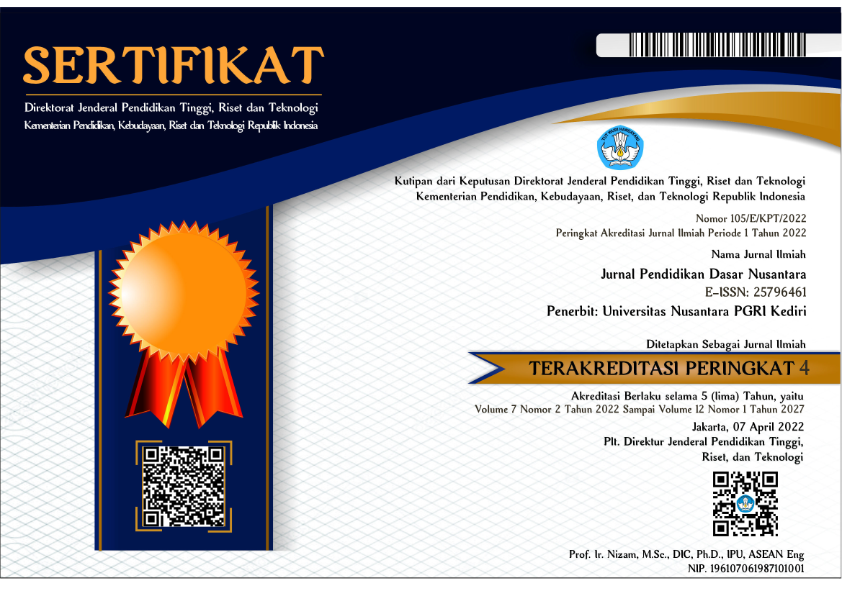MODEL PEMBELAJARAN KOOPERATIF TIPE THINK-TALK-WRITE (TTW) DAN PENGARUHNYA TERHADAP MOTIVASI DAN PRESTASI BELAJAR IPS
Abstract
Abstract: The aimed of this study was to determined the effect of cooperative learning model TTW on motivation and achievement of students learn science. The study was conducted on the social material Junior High School. The subject of research involved 200 people in 7th grade Junior High School of Kubu, Karangasem, Bali. To assess the effect of the above then there are two instruments were used that instrument to obtain data on the learning motivation and learning achievement data. Hypothesis testing is done by using Manova analysis. Research showed that the motivation of students who take social studies learning model TTW with an average score of 103.92, while students who take the conventional learning models have an average score of 75.28. Thus, a significant difference between the application of learning models TTW with conventional learning models in the learning process of the learning motivation of students. Based on the analysis Manova appears that the value of F = 81.145 with a significance level of 0.00. This means that there is the influence of social studies achievement between students who take the learning model TTW with conventional learning models in 7th grade student. The analysis showed that the value of F to Pilla's Trace, Wilks' Lambda, Hotteling's Trace Roy's Largest Root has calculated F = 141.341 0,00 significance smaller than 0.05. That is the value of F to Pillai's Trace, Wilks'Lambda, Hotteling's Trace Roy's Largest Root are all significant. So, their effect learning motivation and learning achievement between students who take the type cooperative learning model TTW with students who take the conventional learning models.
Key words: cooperative learning, motivation, achievement
Abstrak: Tujuan dari penelitian ini adalah untuk mengetahui pengaruh model pembelajaran kooperatif tipe TTW terhadap motivasi dan prestasi belajar IPA siswa. Penelitian dilakukan pada materi IPS SMP. Subjek penelitian yang dilibatkan adalah 200 siswa kelas VII di SMP Negeri Kubu, Karangasem, Bali. Untuk mengkaji pengaruh di atas maka ada dua instrumen yang digunakan yaitu instrumen untuk memperoleh data tentang motivasi belajar dan data prestasi belajar. Pengujian hipotesis dilakukan dengan menggunakan analisis Manova. Hasil perhitungan menunjukan bahwa motivasi belajar IPS siswa yang mengikuti model pembelajaran TTW dengan skor rata-rata 103,92 sedangkan siswa yang mengikuti model pembelajaran konvensional memiliki skor rata-rata 75,28. Jadi, terdapat pengaruh yang signifikan antara penerapan model pembelajaran TTW dengan model pembelajaran konvensional dalam proses pembelajaran IPS terhadap motivasi belajar IPS siswa. Berdasarkan hasil analisis Manova tampak bahwa nilai F hitung = 81,145 dengan taraf signifikansi 0,00. Ini berarti bahwa ada pengaruh prestasi belajar IPS antara siswa yang mengikuti model pembelajaran TTW dengan model pembelajaran konvensional pada siswa kelas VII SMP. Hasil analisis menunjukkan bahwa harga F untuk Pilla's Trace, Wilks' Lambda, Hotteling's Trace, Roy's Largest Root memiliki F hitung 141,341 signifikansi 0,00 yang lebih kecil dari 0,05. Artinya harga F untuk Pillai's Trace, Wilks'Lambda, Hotteling's Trace, Roy's Largest Root semuanya signifikan. Jadi terdapat penagruh motivasi belajar dan prestasi belajar antara siswa yang mengikuti pembelajaran dengan model kooperatif tipe TTW dengan siswa yang mengikuti model pembelajaran konvensional.
Kata kunci: pembelajaran kooperatif, motivasi, prestasi
Downloads
Downloads
Published
Issue
Section
License
Authors who publish with this journal agree to the following terms:
- Copyright on any article is retained by the author(s).
- The author grants the journal, the right of first publication with the work simultaneously licensed under a Creative Commons Attribution License that allows others to share the work with an acknowledgment of the work’s authorship and initial publication in this journal.
- Authors are able to enter into separate, additional contractual arrangements for the non-exclusive distribution of the journal’s published version of the work (e.g., post it to an institutional repository or publish it in a book), with an acknowledgment of its initial publication in this journal.
- Authors are permitted and encouraged to post their work online (e.g., in institutional repositories or on their website) prior to and during the submission process, as it can lead to productive exchanges, as well as earlier and greater citation of published work.
- The article and any associated published material is distributed under the Creative Commons Attribution-ShareAlike 4.0 International License





























